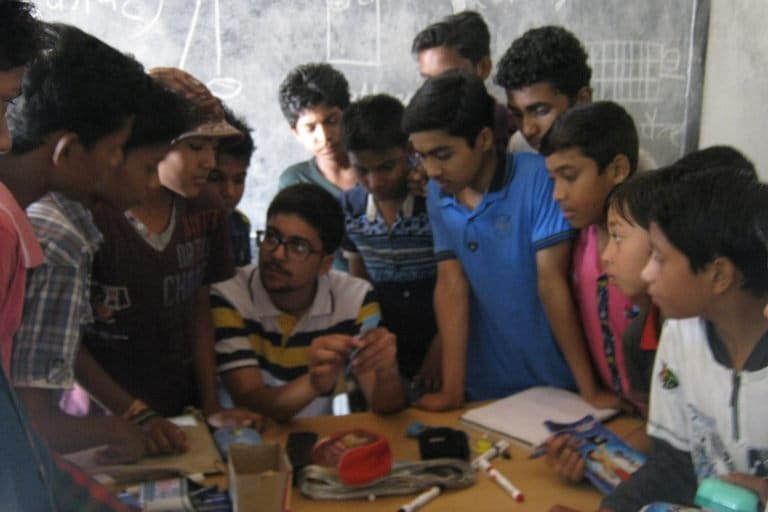- LEDsafari, a startup based in Switzerland is conducting workshops in schools and villages in India on solar technology, integrating innovative instruction with practical training.
- Solar lamp kits are used to help children make a personal lamp using recycled materials that provides light for upto five hours. A one-time total cost for making the lamp is approximately Rs. 580 (USD 8.5).
- Such solutions fill the gap as almost 33 million households in India still await access to stable electricity.
In the government secondary school, Kanker, Chhattisgarh, children are sitting on floor listening intently. A solar lamp workshop is being conducted for students (classes six to ten) from interior Naxalite-dominated villages where there is hardly any access to electricity.
Eleven-year-old Raja creates a hanging solar lamp for his mother who cooks in an unlit kitchen every evening. Raja is scared that she might burn herself while cooking without light.

In a similar workshop in the southern state of Telangana, ten-year-old Arun, from a village near Nizamabad, builds a bicycle solar lamp. Every evening Arun rides a dark road while coming home from a private tuition class.
Life without electricity is unimaginable for city dwellers but a reality and a challenge for many villagers in India.
Recognising this challenge, Govinda Upadhyay, founder and CEO of LEDsafari, conducts workshops on solar technology for children in rural areas without or with limited access to electricity.
He teaches the fundamentals of electronics, renewable energy and sustainability through a hands-on approach in which the children build personal solar lamps using LEDsafari kits, aimed at providing safe and reliable lighting to every child.
The basic solar kit contains a solar cell (the only component that is imported), an LED, a battery of a mobile phone (li-ion battery), a switch and electric wires. Using these, the lamp can be assembled even in a plastic bottle.
Diligent selection of lamp parts discards the need for a charge regulator. Five to six hours of charging in the sun provides light for about five hours in the dark. The total one-time cost is about Rs. 580 ( USD 8.5), lesser than the cost of oil for an oil lamp, which is around Rs. 130 to 200 (USD 2 to USD 3) per week.

Innovation powered by personal experience
In his childhood, Upadhyay spent summer vacations in his father’s village Maranpur in Bihar, which was unelectrified. He understood the inconvenience of living without electricity.
Later, pursuing a PhD in the Netherlands on electrification in developing countries, Upadhyay realised that technology was not the issue as it was getting cheaper and accessible. “The real problem was simplifying and effectively communicating it to villagers,” he said.
Technology intended for industrialised countries becomes ineffective in low and middle-income countries because of a lack of understanding.
As a part of his study, Upadhyay conducted a workshop in the village Maranpur in 2012 to test if people can be trained to build solar lamps. He started with lamps stressing on the bottom-up approach, explaining the concept of electricity as a powerful tool.
“It is great to build something and offer it to someone, but if it breaks it becomes useless if the person cannot repair it,” explained Upadhyay, emphasising on imparting skills-based knowledge.

Initially, LEDsafari conducted on-site workshops through trainers. Today, online trainings are available through animated videos in multiple languages explaining concepts in a pedagogical manner.
Launched in 2016, LEDsafari, has reached almost 20,000 children so far. “It’s a short time but a long journey,” shares Upadhyay, recipient of the EIT CHANGE Award 2015.
The company offers entrepreneurship and education programs, social campaigns and recreational workshops. With 250 trainers, they have built 15,000 lamps, worked with 100 institutes and impacted 60,000 people.
Solar solutions company Mahindra Susten, (part of the Mahindra group) conducted a LEDsafari workshop in Mahbubnagar, Telangana, in December 2016 for 150 students from classes eight to ten.
“It instilled a keen sense of innovation, curiosity and understanding, providing kids the freedom to design after assembling the kit,” said Surmai Kaushik, CSR Executive-Mahindra Susten.
In Lucknow, the Nav Nirman Sewa Trust organised a five-day LEDsafari workshop in the village Kumhraura in November 2016, for 100 participants between the ages of 14 and 65, with different levels of education. The Trust is developing Kumhraura through welfare activities and promoting employment and livelihood projects among the marginalised sections of society.
In this workshop, the participants learned to design, ideate and work with locally-available raw materials.
“They were overjoyed to create a lamp on their own for the first time,” said, Kshitij Singh, Secretary, Nav Nirman Sewa Trust, who feels age, education, social and economic background is never a deterrent for the desire to learn.
The Trust sells the mason jar solar lamps designed in this workshop.

Lighting up the path to change
The last non-electrified inhabited Indian village, Leisang, Manipur was electrified in April 2018, achieving 100% electrification in the country. However, village electrification and household electrification are different aspects.
A village is considered electrified if public places and at least 10% of households have access to electricity.
“Today about 33 million households of the 250 million total households (Census 2011) are yet to be electrified,” shared Abhishek Jain, senior programme lead, Council on Energy, Environment and Water (CEEW).
The government aims to achieve the target by March 2019. However, whether the currently electrified or the to-be electrified households would get a reliable and stable supply is yet to be seen, explained Jain. This, he feels, is a bigger challenge than providing connections to all households.
Given the electricity scenario, sustainable solutions for electrification are useful not just for children but for people of all ages.
Apart from using solar lamps to study at night, learning to make solar lamps also encourages children to think about becoming future solar entrepreneurs. Empowering kids with knowledge and skills for alternative energy solutions can make them agents of change in their homes and communities.
